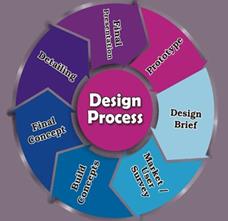Unit IV Design. Types of Designers
I. Vocabulary
Exercise 1. Read and memorize the following words and word combinations:
| 1. design | задум, план, проект, дизайн / замысел, план, проект, дизайн |
| 2. to design | проектувати, конструювати/ проектировать, конструировать |
| 3. applied arts | прикладне мистецтво/ прикладное искусство |
| 4. to originate | створювати/ создавать |
| 5.intention | намір, задум, мета/ намерение, замысел, цель |
| 6.solution | рішення/ решение |
| 7. drawing | малюнок, ескіз, креслення/ рисунок, набросок, чертеж |
| 8. to implement | здійснювати/ осуществлять |
| 9.corporate identity | принципи ділової політики (компанії)/ принципы деловой политики (компании) |
| 10. considerable | значний/ значительный |
| 11. to require | вимагати/ требовать |
| 12. adjustment | узгодження/ согласование |
| 13. irrelevant | недоречний/ неуместный |
| 14.to reduce costs | скорочувати витрати/ сокращать затраты |
| 15.to save time | економити час/ экономить время |
| 16.redundant | зайвий/ излишний |
| 17. pre-production | випуск експериментальної серії / выпуск опытной серии |
| 18. brief | зжатий, стислий/ сжатый, краткий |
| 19.goal | задача, мета/ задача, цель |
| 20. in-situ | на місці/ на месте |
| 21. feedback | зворотній зв'язок / обратная связь |
| 22. environment | оточуюче середовище/ окружающая среда |
| 23. evaluation | оцінка/ оценка |
| 24. advertisement | реклама/ реклама |
| 25. in-house designers | штатні дизайнери/ внутрифирменные дизайнеры |
| 26. freelance designers | позаштатні дизайнери/ внештатные дизайнеры |
| 27.computer-aided design | автоматизоване проектування/ автоматизированное проектирование |
Exercise 2. Guess the meaning of the following international words:
Basis, system, process, product, structure, component, model, result, final, tradition, person, designer, term, aesthetic, aspect, service, situations, typical, analysis, specification, presentation.
Exercise 3. Find in the text synonyms to the following words:
Field, step, products, plan, goal, research, to make.
Exercise 4. Find in the text derivatives containing suffixes 1. -tion/sion; -ment 2. -al, -ive, -ic; -ant; and 3. -ly of the following words, say to what part of speech they belong and translate them:
1. to suggest; to evaluate; to describe; to conclude; to continue; to implement; to celebrate; to require; to improve; to develop.
2. graphics; virtuality; culture; aesthetics; function; consideration; construction; interactivity; redundancy; irrelevance;
3. professional; universal; usual.
Exercise 5. Translate the following word-combinations (noun with a prepositive attribute):
Design process; graphical user interfaces; corporate identity; design areas; fashion designer; concept designer; web designer; design goals; design solutions; product design specification; pre-production design; post-production design feedback;future designs; future improvements; design process activities; freelance designers; in-house designers; computer-aided design.
II Reading
Exercise 6. Read and translate:
Text A What is Design?
  |
Design is the planning that lays the basis for the making of every object or system. It can be used both as a noun and as a verb and, in a broader way, it means applied arts and engineering. As a verb, "to design" refers to the process of originating and developing a plan for a product, structure, system, or component with intention. As a noun, "a design" is used for either the final (solution) plan (e.g. proposal, drawing, model, description) or the result of implementing that plan in the form of the final product of a design process. The final product can be anything from socks and jewellery to graphical user interfaces and charts. Even virtual concepts such as corporate identity and cultural traditions such as celebration of certain holidays are sometimes designed. More recently, processes have also been treated as products of design, giving new meaning to the term "process design".
The person designing is called a designer, which is also a term used for people who work professionally in one of the various design areas, usually also specifying which area is being dealt with (such as a fashion designer, concept designer or web designer). Designing often requires a designer to consider the aesthetic, functional, and many other aspects of an object or a process, which usually requires considerable research, thought, modelling, interactive adjustment, and re-design.
A design process may include a series of steps followed by designers. Depending on the product or service, some of these stages may be irrelevant, ignored in real-world situations in order to save time, reduce costs, or because they may be redundant in the situation.
Typical stages of the design process include:
Pre-production design
1. Design brief - the beginning statement of design goals.
2. Analysis - analysis of current design goals.
3. Research - investigating similar design solutions in the field or related topics.
4. Specification - specifying requirements of a design solution for a product (product design specification) or service.
5. Problem solving - conceptualizing and documenting design solutions.
6. Presentation - presenting design solutions.
Design during production
1. Development - continuation and improvement of a designed solution.
2. Testing - in-situ testing a designed solution.
